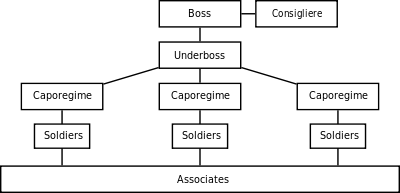Capodecina

A capodecina (literally 'head of ten',[1] also called caporegime in the American Mafia) is the head of a decina, a branch within a Mafia family. In the larger families, a capodecina is selected by the head of the family and coordinates units of about ten people.[2]
Mafia members are organized under the supervision of a capodecina who reports to the capo famiglia, the head of the Mafia family or cosca. The term derives from dieci (ten), suggesting that each would be in charge of ten men.[3] The term was mentioned as early as the 1880s in Sicily to describe the organisation of the Fratellanza, a Mafia-type organisation in Agrigento, in the south of Sicily.[4]
The Mafioso Melchiorre Allegra spoke of a "capo della decina" in his 1937 testimony. He said a family split into groups of ten men each when it became unmanageably large.[4][5]
References
- ↑ Schneider, Reversible Destiny, p. 83
- ↑ Paoli, Mafia Brotherhoods, p. 41
- ↑ Gambetta, The Sicilian Mafia, p. 111
- ↑ 4.0 4.1 Gambetta, The Sicilian Mafia, p. 294
- ↑ Twentyfive pages of Allegra’s testimony were published in 1962 in the newspaper L'Ora by Mauro De Mauro. See: Testimony of Melchiorre Allegra, ExLEGI website
- Gambetta, Diego (1993).The Sicilian Mafia: The Business of Private Protection, London: Harvard University Press, ISBN 0-674-80742-1
- Paoli, Letizia (2003). Mafia Brotherhoods: Organized Crime, Italian Style, New York: Oxford University Press ISBN 0-19-515724-9 (Review)
- Schneider, Jane T. & Peter T. Schneider (2003). Reversible Destiny: Mafia, Antimafia, and the Struggle for Palermo, Berkeley: University of California Press ISBN 0-520-23609-2
| ||||||||||||||||||||||||||||||||||||||||||